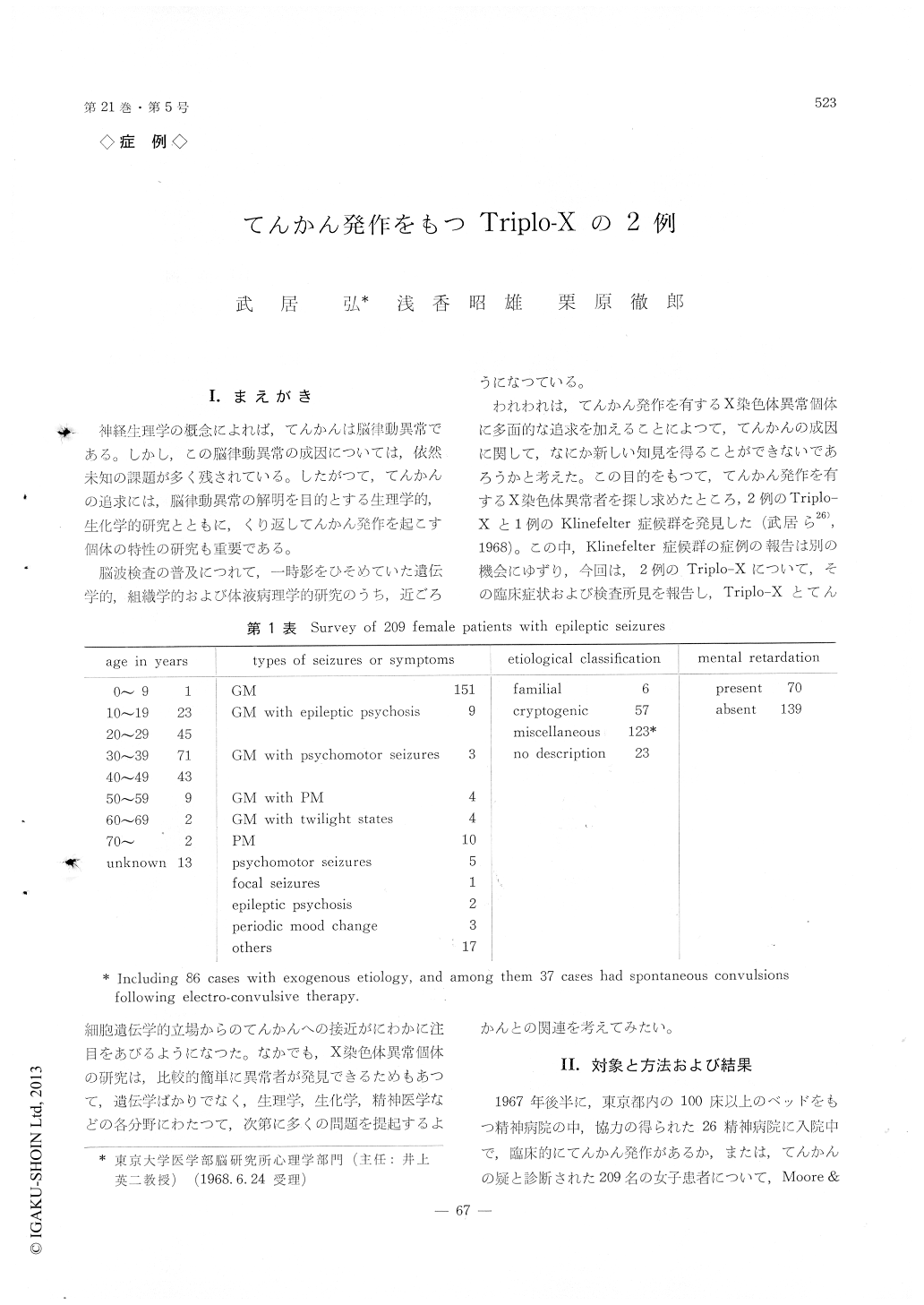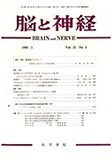Japanese
English
- 有料閲覧
- Abstract 文献概要
- 1ページ目 Look Inside
I.まえがき
神経生理学の概念によれば,てんかんは脳律動異常である。しかし,この脳律動異常の成因については,依然未知の課題が多く残されている。したがつて,てんかんの追求には,脳律動異常の解明を目的とする生理学的,生化学的研究とともに,くり返してんかん発作を起こす個体の特性の研究も重要である。
脳波検査の普及につれて,一時影をひそめていた遺伝学的,組織学的および体液病理学的研究のうち,近ごろ細胞遺伝学的立場からのてんかんへの接近がにわかに注目をあびるようになつた。なかでも,X染色体異常個体の研究は,比較的簡単に異常者が発見できるためもあつて,遺伝学ばかりでなく,生理学,生化学,精神医学などの各分野にわたつて,次第に多くの閥題を提起するようになつている。
Sex chromatin screening test was performed on 209 female inpatients with a history of epileptic seizures (Table 1) at 26 mental hospitals in Tokyo. Two females with double sex chromatins were found, and their karyotype was shown to be both 47, XXX (triplo-X). by peripheral lymphocyte culture (Table 2, Fig. 1). The frequency of triplo-X individuals among the present population is thus 0.95%, which is higher than those reported among newborn as well as mentally retarded females.
Case 1 (Fig.2) is 56 years old. She was born as the father was 24 and the mother was 19 years of age. A paternal uncle was heavy drinker, and a relative on the maternal side was said to have had mental dis-order. She was said to have suffered from men-ingitis at age of 6. Since 6 and a half years of age, she had occasional convulsive until the age of 30. She married at the age of 26, became pregnant next year, but miscarried within a few months, and was divorced soon after. When she was 48 years of age, she was admitted to a mental hospital because of delusions of reference, persecution and poisoning. The diagnosis of schizophrenia was made. After 3 months she improved and was discharged. At the age of 52, she suffered front cerebral hemorrhage, and was readmitted to another mental hospital where she was noted to have ideas of reference and per-secution, a marked epileptic personality change and left facial paresis. No convulsive seizure was noted since the admission, but occasional syncopes were seen. When examined by the present authors, I. Q. was 62. Public and axillary hairs were scanty, but no gynecological or urine hormonal abnormality wasfound. Other findings were hypertension, heart di-latation, chorioretinitis, tuberculous lymphadenitis of the neck and syphilis. EEG record was abnormal with paroxysmal pattern at the right parietal and occipital areas (Fig. 3).
Case 2 (Fig. 2) is 46 years old (?). Since she was brought to the mental hospital by a policeman as she was wandering about, no exact family and past histories could be available, but she said she had suf-fered from a brain disease in her childhood. She was severely mentally retarded, and because of excite-ments and quarrels with other patients, she received 12 electro-convulsive treatments during a period of 3 years. After the last treatment spontaneous convulsive seizures appeared, and a marked epileptic personality change was seen. When examined by the present authors, I. Q. was under 20. External genital organs were infantile, and she had scanty axillary and public hairs. Other secondary sexual characters and urine hormones were normal. The fingers of both sides, especialy third and fourth fingers, were markedly abduced at the second inter-phalangcal joints. PEG was normal, and EEG showed borderline abnormality with a slow alpha basic activity and a small amount of slow waves, which suggests a hypofunction of the brain (Fig. 3).
The increased frequency of triplo-X individuals among female epileptics suggests an association of triplo-X constitution with epileptic seizures. Some of the authors (Table 3) discussed the relationship between two pathological conditions. Accumulated cases of triplo-X females showed less marked physical symptoms, but more prominent neurologic and psy-chiatric symptoms such as mental retardation, mental disorders, EEG abnormalities, dilatation of the cereb-ral ventricles and epileptic seizures, as compared to 47, XXY (Klinefelter's syndrome). Triplo-X females may also have a lowered seizure threshold, compared to individuals with normal X-chromosome comple-ments (Table 4). Therefore, the association of triplo-X constitution with epileptic seizures may be clue to lowered seizure threshold in this particular type of X-chromosome hyperploidy.

Copyright © 1969, Igaku-Shoin Ltd. All rights reserved.


